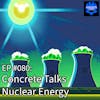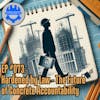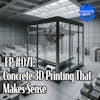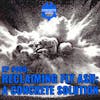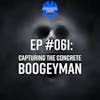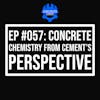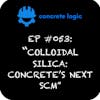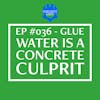EP #054: Concrete Contractors' 12 Most Essential Books
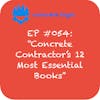
📚👷♂️ Are you a concrete contractor or just passionate about the industry?
Don’t miss our latest episode, “Concrete Contractors’ 12 Most Essential Books”! 🎧
We’ve got Jim Klinger from the American Society of Concrete Contractors (ASCC) sharing his top book recommendations for anyone in the field. 📖 From technical guides to insightful reads, these books are sure to improve your knowledge and skills.
🏗️ Tune in and find out what books you need to be considered to be the best concrete contractor! 💪🔨
Episode References
Guest: Jim Klinger | American Society of Concrete Contractors | jklinger@ascconline.org
Guest Website: https://ascconline.org/
Producers: Jodi Tandett, Olivia Stocker
Become a Producer: https://concretelogicpodcast.com/show-support
Music: Mike Dunton | https://www.mikeduntonmusic.com | mikeduntonmusic@gmail.com | Instagram @Mike_Dunton
Host: Seth Tandett, seth@concretelogicpodcast.com
Host website: concretelogicpodcast.com
Seth (00:00.959)
And welcome to another episode of the Concrete Logic Podcast. And today I have Jim Klinger from the American Society of Concrete Contractors, better known as ASCC. Jim, thank you for coming back on the show.
Jim Klinger (00:14.302)
My pleasure, thanks for inviting me. I really appreciate it.
Seth (00:16.455)
Yeah. No, when we were done with recording the last episode, we were, maybe not purposely brainstorming, on a new, the next episode. And you said a good, a good thing for us to discuss would be, the books or reference materials, all, great concrete contractors should read.
And so that's what we're doing today. That's what you and I are getting together and we're going to discuss that. And so, if you don't mind, why don't you kick us off? Where, why are we talking about this today? And then we will get rolling into the different materials that we think we all should read.
Jim Klinger (01:04.194)
Sure, well, you know, a lot of the phone calls that I get from our members, as it turns out, looking back on it, there's a lot of those calls probably didn't need to happen if the concrete guy would read certain documents, have things available right on his desktop. And so based on what we talked about last time, I made a list of things that I used over the years.
I found it to be quite valuable. And a lot of these, I guarantee, if you have them and you know them, you're gonna make money or you're not gonna lose money. Let's look at it that way. So top of the list, ACI 301. Not really a book, it's a document, specifications for concrete construction. The latest edition is 301-20.
And before that was 301-16. So, you know, you go, well, you can't really print them anymore because they got it. There's like a, like a print wall, like a paywall, right? From ACI. But if sure. So, if you found a way, what I did was I printed it out and did a three-ring binder and I kept it on my desk.
Seth (02:13.271)
Yeah, they gotta make money somehow, I guess.
Jim Klinger (02:25.17)
And you just read through page by page at lunchtime or something. It's the whole business is in this document. Now, or for some time, the way they have it worked is all a design team has to do is mentioned ACI 301 in the specs and you as a contractor now own that document. They made a little refinement.
If the engineer or the design team in the specs says that you have to do the work per ACI 301, what that means is you own unless otherwise specified, sections one through five only. Anything more than that, they have to specifically bring up in the specs. And so, you say, okay, well, what's in the first five sections that I now own? And, you know, general requirements.
They talk about submittals. What's what is required for submittal pre-construction meetings, testing, and inspection, there's a section on formwork, a section on reinforcing steel, and a section on mixed designs. And, and then section five is handling, placing tolerances, surface finishes, all that kind of stuff. And then you say, okay, well, well what's beyond Chapter 5?
Section six, architectural concrete. So, they can't just put in their documents, hey, Mr. Contractor, you own 301 architectural concrete. They have to specifically go through and pick out the parts that apply to the projects. In other words, they have to do some thinking before they write their spec. There's a section in seven, lightweight concrete. Section eight, mass concrete.
Jim Klinger (04:21.894)
Industrial slabs, tilt, precast, those kinds of things are all specialized topics that have to be specifically referenced in your design documents. But in the first five sections, they just have to write one sentence and you now own it. So, I would recommend that, you know, what I tell our callers is to print this out, put it in a binder,
And just go through every day at lunchtime for an hour or something, you know, or a half hour, whatever it is. And, and you find that you, you start looking through this and you, there's things that maybe you forgot or things you didn't know before. And to this day, I'll go through it and I'll, I'll see something that I didn't really see before or understand before it's, if you, if you had, if you had to get one document and that's all you had, I would go to that.
And then of course, in there that references all the ASTM standards that you need to know and other ACI documents that you should have on your desktop.
Another one is ACI 117 is tolerances. Obviously, that's for your, you know, the allowable deviations and so on that you're allowed as you do your foundations or your cast-in-place concrete rebar.
Mix, you know, some of your mix design information is in there and maybe even more important is 117.1 Which is the guide to tolerance compatibility so that is now that you have 117 tolerances, how does that work with all of the follow-on trades and that is just a Fantastic document in there.
They talk about the history of tolerances, how they're supposed to be measured, who's responsible for doing what in the course of the design, who's supposed to coordinate the tolerances, and then how does that work with your follow-on guys? So, for example, there will be a section on elevator shafts. So they'll have a table. What is the ACI tolerances and what is the elevator guy? What is his industry?
Telling him that his tolerances should be, what are his expectations? And they do structural steel, window wall, curtain wall, block, ADA, all of these different topics. And so that we use, I mean, two, three times a week, I'll end up going to that document to help out one of the members with a coordination issue or some kind of an issue with a follow on trade, some kind of a conflict or whatever it may be.
Another one that is ACI 318, the design code. Now, this is what, five, six hundred pages now? Almost six hundred pages. And they tell you that this is something that is really not written for the contractor. You know, it's written for the design team and so on.
But there is a chapter in here, Chapter 26, that is very valuable to the concrete contractor. It tells you what is the design team supposed to be showing on their drawings. What are they supposed to be calling for in their specifications? How do you do a mixed design? What information do you need to include? Acceptance of concrete. What kind of testing is involved? How often? What type of test?
Jim Klinger (08:18.471)
Different things from the inspection standpoint, all in chapter 26. So, if nothing else, I would get this big book just for that one chapter. Just a fantastic document. And you gotta know as a contractor what you owe the project going into it.
And you're going to find that here. This is what the engineer is going to be looking at when he decides to put in his contract documents, what you owe. So, you should, you should know the other guy's playbook, right?
Seth (08:58.771)
Yeah. And that was 318. Is that what you said?
Jim Klinger (09:01.09)
That's 318. That's the building code. That's the whole nut right there.
Seth (09:05.275)
Yeah, that's the big one. Yeah. As you're going through these, I'm looking them up. Yeah. That one's 624 pages long., and obviously they have the digital versions on their, ACI store. They really pushed the membership. So, you get the cheaper price too.
Jim Klinger (09:28.822)
Well, you know, and they tell us now that the, you know, I'm on one of these committees and, and they tell us that the objective is to try to streamline the code and make it smaller. When I first started in the business, you could, you could take 318 and fold it and put it in your back pocket. You know, it was like maybe a hundred pages or, you know, this thing, you got to worry about sticking this in your, in your, in your suitcase, going to the airport. I mean, it weighs, weighs quite a bit. But anyway….
Seth (09:49.18)
Right.
Jim Klinger (09:58.83)
You know, even though they tell you it's not geared towards the, you know, the contractor's not the audience, I would get a copy of it just to know what the other guy's playbook is. And then there is, like I say, section 26 is something that's very important to the concrete contractor.
Seth (10:21.779)
Yeah. Well, especially too, if, as a contractor, if you're participating in, in projects that are design-build, you definitely want that reference as well. , and you can back check, your design team friends, make sure they're, actually correct.
Jim Klinger (10:41.738)
You know, we get called every couple of weeks. , you know, Hey, we, we just got, we just got, and they're telling us we have low breaks. , you know, do we need to start coring that kind of thing? And so it's helpful to understand what is going on in the engineer's mind so that you can help, prepare, your counter to whatever they're telling you.
You know, how to proceed next through the testing. Do you really need to be taking cores? Or is it something that can be solved with a pencil and a calculator and a little bit of engineering judgment?
Seth (11:15.081)
Yeah.
Seth (11:22.847)
Is there any, Jim, do you know, is there any rhyme or reason for when they update these things, is there a, is there a time period that like, do they do it every two years, four years, or something like that?
Jim Klinger (11:35.698)
Yeah, each one of these has a, like ACI 301, right now the current one is 301-20. Before that it was 16. So, and before that, it could have been like 10 or something. ACI 117, the latest copy is 117-10. They were supposed to have a more current version, but because sometimes with ACI, though, wheels of progress grind slow. And so ACI 117 won't be updated. I'm gonna say, you know, maybe 24, 25. ACI 318 right now, the latest edition is 318-19. And we're working on this code cycle will be, and that will be on time. 318-25 will be the next version of that. So, 301 you're probably not going to see here for another couple of years.
Jim Klinger (12:48.985)
So, for ACI, there's another document, and it's called the ACI Field Reference Manual, MNL 15. Now here's one that you buy, and we're talking less than 200 bucks, right? So, for that, that combines all of the ones that we just talked about except 318. You got 301, 117, 117.1R, which is the tolerance compatibility, 211, which is how to do your proportion of your mix designs, and 224 causes evaluation and repair of cracks. And I mean, it just goes on and on here. Guide to hot weather concrete. Guide to cold weather concrete, different specifications, curing, guide to formwork for concrete, and so on. And so, all of these are in one, well, now it's a PDF file. But that is, you know, if you, had that, you had the whole ball of wax for, for $200. And, you know, I think that they.
It is ridiculous that they charge 200 bucks. It's probably $2000 is probably a more fair price for what you get. It's really cheap. So, for the contractor that doesn't wanna spend money up front, you're doing yourself a disservice. I mean, spend the $200 and get, every one of your field guys should have this, especially now since it's a PDF file. They don't have to carry around a five volume set with 2,000 pages of paper. It's all in a searchable PDF file.
Seth (14:42.859)
Yeah, so that was the MNL-15. And it looks like the current version is from 2020, field reference manual. And on the website, on ACI's website, it's $194 for a member, $239 for nonmembers. And it's $194.
Jim Klinger (15:06.438)
Yeah, 200 bucks. And for crying out loud, you could make that back in one phone call, right? Or one reading. So, the value there is just tremendous. And so, then we have a collaboration between ACI and ASCC.
Seth (15:17.962)
Oh yeah.
Jim Klinger (15:36.374)
You know, one of the committees is 117 tolerances where we've collaborated for that. And then we have here the contractor's guide to quality concrete construction. This is also known as ACI MNL-5. Okay, so you can buy this on the ACI website, or you can buy it on the ASCC website. And I think right now.
We're talking about 60 bucks, 70 bucks or something for this. And again.
Seth (16:09.687)
Is that the, I'm sorry to interrupt, is that the fourth edition? Is that the one we should be looking for?
Jim Klinger (16:14.798)
It's a M&L fourth edition. That's the one right here.
Seth (16:19.863)
Okay. Yeah, it's, I'm on ACI's website. It's 69 bucks for members, 99 bucks for, non-members. And yeah, there's a lot.
Jim Klinger (16:35.714)
So, in here, chapter one, safety, which is good. And then it follows quality control and how to do quality work for concrete mix design, specifications, foundations, form work, rebar, joints and embeds, slab on ground, planning for quality, planning for concreting, placing and finishing, common field problems, legal issues.
And then at the back is all of the ASCC position statements. Now keep in mind, this is up to 43. I think we're up to like 46 or 47 now. But still, the value of these position statements is tremendous. You know, we get calls all the time from members that say, jeez, you know, we have the cost of membership to join ASCC. We just made that back in one phone call. You know, thanks a lot. So, these position statements are incredibly valuable. So, this is another that should, it should be on every superintendent's desk. Every foreman in the business should have one of these. And what I say is that,
Seth (17:46.124)
Yeah.
Jim Klinger (17:59.806)
It's a structural engineer should have a copy of this and the architects. There would be value for those folks to read this, to understand what it is they're putting on their drawings and specifications. In some cases they might not know, and so, you know, full of photographs and really good information. When the folks put this together, they did a fantastic job. So, 60 bucks, 70 bucks, whatever it is, fantastic value there.
Seth (18:37.251)
Do you know the origin of that manual? Why did ACI and ASCC get together to put that one together?
Jim Klinger (18:45.59)
You know, it's, I wasn't there when this happened, but it's committee E-703, concrete construction practices. And you know, you got, who were the guys that were involved in this? You know, Scott Anderson, Bev Garnett, Mike Hernandez. Those are all folks that, you know, names you recognize.
So, it was a collaboration between a lot of people, experts, all experts in the field. We had an attorney help with the chapter on the legal stuff. So highly recommended. That should be on all of the superintendents at a minimum, should have that on their desktop. And I think now it's available on PDF as well.
I prefer the hard copy. PDFs get lost easily. If you've got that book on your desk, chances are you might pick it up and go through it from time to time.
This is another one here that is. I don't know if the right word is under-reported, but a lot of folks don't know about this one, Tolerances for Cast-in-place Concrete Buildings written by Bruce Suprenant and Ward Malisch.
This has been out for quite a while. I don't think you can get the hard copy anymore, but, it's definitely available on PDF at our website. It's $35, you know, for crying out loud. This is a fantastic tour de force on tolerances. It's got the history of tolerances, all the ACI 117 information going back years and years, which is a value to know what were they looking at in the 1940s and 1950s. Sometimes it pays to be able to, when you're arguing a case, to say, look, this is the way it used to be, and here's the way it is now. This is what changed, and this is why that's a value. To me, I use this all the time.
I bought a bunch of hard copies when the hard copies were available because they would get dog-eared. I would go through them, I'd put sticky notes on them, I'd make marks on them, and then the thing would start to, you know, I'd be using it so much it would come apart so I would just get a replacement. So, I bought a bunch of these.
Seth (21:29.268)
Can you say that title again? What's the title?
Jim Klinger (21:31.726)
Tolerances for Cast in place Concrete Buildings. And if you're a project engineer, if you're doing layout, if you're doing surveying, superintendents I think would find this a value. It's just, I can't crow enough about this one. It goes through all the different tolerance topics and then specialty topics. You know, it's like, let's say you have a concrete core, and the concrete guy builds that core exactly where it's supposed to go. And it has embeds in the wall. And then the steel guy comes in and he follows his tolerances exactly. Well, it could very well be that it won't work. There's no coordination between the two. There's an overlap or there's a bust between the two trades. And so, things like that are pointed out in this book. I can't say enough about it anyways. I think it's, anybody in the business that has anything to do with tolerances should have this on their desk.
Jim Klinger (22:55.67)
Another one, ASCC Guide to the Design and Construction of Concrete Toppings for Buildings. If you're doing topping slabs, this is Scott Tarr, Ron Kozikowski, and Matt Sheehan wrote this one. That's available on our website, $35. I don't know how many calls I get.
Guys have issues with topping slabs, bonded slab, unbonded, toppings on precast, and so on. Cracking in the toppings, that kind of thing. Probably, you know, probably a hundred pages or so, very well done. So, if you're in the business and you're doing topping slabs, I would spend the $35 and get this.
And I don't know, I don't think this is on PDF. It may be, may just be a hard copy.
Seth (23:58.963)
It's not, I'm looking at it right now. It says low stock too. You guys need to get some more. Print some more books or get the PDF version.
Jim Klinger (24:09.605)
So, I know, well, you know, Scott Tarr has been doing articles in Concrete International and so on for many years now. He's on a lot of the committees and does good work. And this is really good, really good job on this, on this document.
Seth (24:26.603)
Yeah, I can't say the other guy's name. It's Scott Tarr and Ronald.
Jim Klinger (24:30.336)
Koxikowski, Scott Tarr, Matt Sheehan.
Jim Klinger (24:36.526)
Such a fantastic job on that. And again, 35 bucks, man. It's just staggering to me.
Seth (24:44.131)
If you're an ASCC member, cause the price I see right now is $55, not that it matters. It's 20 bucks.
Jim Klinger (24:51.218)
Okay, well, all right, let's just say, let's just, yeah, let's just say $55. You get in a problem on it. It's not a $55 problem, right? On a job.
Seth (25:01.187)
Yeah, no, I mean all these, all these things that we're talking about, the cost of these things that well worth it. Some of these disputes you get into they're tens of thousands of dollars. So buying some books that's minuscule.
Jim Klinger (25:14.274)
Well, you know, on the other hand, you know, ASCC and ACI are both nonprofit organizations. And I think this just proves that, right, that they're not out there to soak you for dollars. You know, a lot of these a lot of these technical books, you go to buy structural design books or whatever, you know, you're talking hundreds and hundreds of dollars and they're probably worth it, you know, at that price point. So
Here's another one that is fantastic work right here. This is by NRMCA, National Ready Mixed Concrete Association, and ASTM, American Society of Testing Materials. It's the User's Guide to ASTM C94, which is the specification for ready-mix concrete. And that's, you know, we're in the concrete business and every day when we pour concrete, you're a following C94. This is a, you know, this is a part of your life right here.
What these guys did was they took that standard line by line and explained what it is, what it means, how they got there, what some of the history is behind it, and so on. And this one, I didn't know about this probably till kind of too late in my career. I wish I'd have known about this earlier, but it goes through a lot of the things that happen at the batch plant, different things about when can you add water, at the job site, what about batch to placement time, you know, the 90-minute rule and so on.
So, this is Gene Daniel and Colin Lobo. Just a fantastic piece of work here. And this one is, I found the price is $89.
Seth (27:31.272)
Yeah, that's what I found. I'm on astm.org.
Seth (27:41.483)
Second edition. Is that the second edition?
Jim Klinger (27:41.518)
So yeah, it's also available in searchable PDF.
Seth (27:50.635)
Yeah, that's my, that's my preference. It'd be a toting around a, you're going to have to tote around like, box truck to carry all this stuff. Jim.
Jim Klinger (27:53.794)
Well, you know.
Jim Klinger (28:05.794)
It's not only searchable, but it's printable. And the ACI documents nowadays are searchable, but not printable. I don't know why that is, but that's the choice they made. And it's.
It's aggravating sometimes. I'd like to be able to print two pages from 318 or to send it to somebody that's called in and looking for some help. But you gotta go through the thing where you do a screen cap and cut and paste or whatever. So.
Seth (28:43.971)
Yeah.
Jim Klinger (28:49.218)
Here's another one. Formwork for Concrete. This is SP-004, 8th edition. Before it had been many, many years. I don't know if it was 20 years or whatever. But this is the latest edition. Right now, it's $159 is what I saw on the ACI website.
Again, this is a collection of, I don't know, 20 industry experts. They got together and wrote this. They spent obviously a lot of time and it's got the latest information, everything you want to know about formwork, material, cycling, shoring, reshoring, and safety.
All of that is in this. And again, for any superintendent that deals with formwork, I would recommend this be on their desk. And I don't think this, I don't know if this is available on PDF or not.
Seth (30:07.003)
It looks like it is. It's a, another protected PDF, on ACI's bookstore. $264.00 for a member.
Jim Klinger (30:21.954)
So, and then, you know, your formwork designer that you hire to do your submittals at the beginning of a high rise project, he's gonna be looking at this. He's gonna be living and breathing this. Anybody that orders materials, you know, it's how to form certain things are in here. You know, just a fantastic piece of work. So, highly recommended for the price there. See another one here.
Jim Klinger (31:02.594)
We talked about this a little earlier, but I want to mention one thing. ACI 302 Guide to Concrete Floor and Slab Construction. So, this is pretty much everything you want to know about place-finish, concrete slabs and so on. But of value is page one, just this cover sheet.
There's an introduction. Even with the best floor designs and proper construction, it is unrealistic to expect completely crack- and curl-free floors. Consequently, every owner should be advised by both the designer and contractor that it is completely normal to expect some amount of cracking and curling on every project and that such an occurrence does not necessarily reflect adversely on either the adequacy of the floor's design or the quality of its construction.
So in other words, slabs crack, they move, and that's just what you get when you get concrete. And that's just the cover. That's even before you get into the document itself. And this is of value. You know, I have members use this all the time.
When they get a complaint, oh, you know, hey, Mr. Contractor, your, slabs got a crack in it. You know, you better tear it out, or time for you to get out here and repair that crack. And this is, you're not even into the document. And this is, this is very valuable to have.
Seth (32:52.119)
Which version is that? What publication year is that one that you got set to 2015?
Jim Klinger (33:01.074)
It's a 302.1R-15 Guide to Floor and Slab Construction. Fantastic, fantastic document.
Seth (33:10.517)
Okay.
Jim Klinger (33:16.226)
So, all your place and finish guys, again, I would recommend all of the superintendents and foremen have a copy of this. And I know, you know, a lot of these guys, they can't expect their foreman to be carrying a bunch of books around, but maybe just keep it at home or at least have them leaf through it and understand what's in here. You know, I guarantee that you'll make money.
Or you won't lose money if you know what's in these documents.
Jim Klinger (33:52.674)
Here's another one that's probably not for everybody, but it's on my bookshelf. ASTM, Significance of Tests and Properties of Concrete and Concrete-Making Materials.
Jim Klinger (34:16.296)
I don't know what the price of this one is. This one's probably a couple hundred bucks from ASTM. You're talking almost 700 pages, but pretty much everything you wanna know about concrete, lightweight concrete, shotcrete, and so on is in here. And of course, they refer to the ASTM C94s and...
So, on all of the standards that are behind that. And here you have a lot of the industry experts writing articles that explain, pretty much, the nuts and bolts what's behind a lot of these standards. So this one, I find a value from time to time.
Just recently, we had a case where there was a concern about concrete cover over reinforcing steel and fire codes. What it said in this book was if you have the steel right at the surface of your wall, then you're going to have a problem with the fire. But as you get more and more cover, the effect is less and less. By the time you have three inches of cover, you should be able to hold the bar in your hand.
Little things like that just kind of put things in perspective.
Seth (35:50.051)
Yeah, I found it. Back to the ASTM.org site. It's $156. And it's a PDF. It says, the new edition of this popular ASTM publication covers cement and concrete quality, ready-mix concrete, sampling and testing techniques, strength testing, abrasion resistance, NDT. What's NDT?
Jim Klinger (35:59.222)
That's a bargain.
Jim Klinger (36:19.403)
Non-destructive Testing.
Seth (36:21.655)
Oh, okay. Elastic properties, creep and relaxation, concrete aggregates, hydraulic cements, and much more.
Jim Klinger (36:30.402)
Petrographic examination, time of set, what's that all about? Bleed water, what's that? Factors influencing workability, air content.
Seth (36:45.779)
Yeah, it's got 56 chapters.
Jim Klinger (36:50.53)
Durability, alkalized silica reactions, what's that all about? Hardened concrete, slag, shotcrete, cellular concrete, concrete for radiation shielding. We get that every once in a while. Somebody's like, the latest call we got was a veterinary clinic where they have a room set up for x-rays and all of that. And they had to have specialty concrete and steel lined vault there for the machinery and so on. I mean, all kinds of topics here. SCC, self-consolidating concrete.
And just again, so this is of value because you have industry experts that wrote, I'm going to call it a scholarly type paper explaining all the topics that we just went through, why you see certain things. There's going to be, this is based on testing and so on. So, I found it to be of value on my desk. But this one, I mean, I wouldn't expect, say, a foreman to be carrying around. But a project manager or estimator, I think this would be a value, especially, you know, more management type than a field guy, let's say.
Jim Klinger (38:43.946)
Another thing, ACI 301, when we were talking, all they have to do is just mention in the specs work to be per ACI 301 and you own the first five chapters of this. But a lot of folks overlook, or they don't realize that at the end of this document, there are two checklists there: mandatory requirements and optional requirements.
And the mandatory requirements, that's there, if the design team is going to refer to 301 and make that a part of your contract, then they also are required to go through this mandatory checklist line by line and find the things that apply to your project and put them in your contract and make sure those items are covered.
That's mandatory. There's no, you know, that's mandatory language. It shall happen. It's not, it's not an optional thing. Then there's also an optional checklist at the end that may or may not be used by the engineer, but the mandatory for sure.
And the same thing goes with ACI 117. You know, a lot of guys look at the first three, four chapters of tolerances and they stop. But at the very end of that document is a mandatory checklist that would be a good idea for anybody to go through. And just at least familiarize yourself with what's there so that when...
When you get in a dispute on a job or whatever, and somebody's telling you, you owe something, make sure you understand who owes what and why. A lot of times the guy on the other end of the phone doesn't know. A lot of these engineers and design guys don't know that there's a mandatory checklist at the end of 117 or at the end of 301. I think there's a lot.
Seth (41:01.375)
Yeah.
Jim Klinger (41:02.594)
So that's why I was saying this is, it always pays to know the other guy's playbook.
Seth (41:13.599)
Yeah, that's an understatement. , so we went through about a dozen references and it sounds like, , I was going to ask you what it, if you were to tell someone, tell a concrete contractor of the dozen or so references we went through and said, you got to have these three or four of these references. , for sure.
I think the obvious answer to one of them is ACI 301. You definitely got to have ACI 301. So, what are the two or three other ones that you would say?
Jim Klinger (41:51.342)
If I wanted to cheat, I would say get MNL-15 because there you get 117, 301, 302, 224. You get all those in that one file for what is it, $197. But if you only had one or two, I would go ACI 301 for sure. And that is just, you know, just open that up and just start going through page by page. And it's a great memory refresher.
It's you know, you're going to have to know this at one point or another. And you contractually own that. That's what you owe the project. So, it's kind of. I mean, would you want somebody working for you out in the field producing work and they didn't understand what they owed the project? So. That's the value in 301.
And I think it's underused, I think.
Seth (42:55.394)
Yeah.
Seth (43:00.467)
Yeah, and so 301 and the MNL-15 the field reference.
Jim Klinger (43:06.83)
117.1 R, The Tolerance Compatibility with Other Trades, huge value there. Because I mean, almost all the disputes you're going to get into have to do with the follow on guy is beefing because your work doesn't meet his substrate requirements. You know, it's the flooring guy or the block guy or the window wall guy or the curtain wall guy or the steel guy. It's everybody that comes after you.
This note tells you how to deal with those situations, and it tells you what the other guy's tolerances are and what yours are. So, when you go to that pre-construction meeting, you can talk to the architect or whoever's there and say, look guys, we're the first ones out to chute. We're gonna be doing our work first, and we're gonna take advantage of every tolerance envelope that we have. We're gonna ride that thing. We're gonna ride that envelope.
The rest of these guys need to understand that we have industry tolerances, and they need to adjust to us. So, make sure that you've coordinated and understand that slab edge is gonna be plus or minus one inch. Or the top of slab is gonna be plus or minus three quarters. We own that, that's our tolerance. That's what we owe for the job and we reserve the right to give you what we owe you.
Seth (44:33.215)
Yeah. And then, obviously, maybe not obvious, but we talked about a little, about a lot about them last time was your, ASCC, The Position Papers. So those are a great reference as well. And those are free.
Jim Klinger (44:50.23)
So yeah, they're at the back end of the quality guide. So that's a roundabout way of getting, but you know, even somebody that's not an ASCC member can go to our website right now and read those position statements. You can't print them. There's a print wall. You have to be a member to be able to print those, but you can at least read them.
Seth (45:15.533)
Yeah.
Jim Klinger (45:16.534)
That's a free service that we provide to all the concrete contractors, whether you're a member or not. There's a lot of information on our website that's free to everybody. Again, we're a non-profit, so we're here to help each other. Nobody else is going to help us, so we've got to help each other.
Seth (45:37.311)
Right. Well, that was great, Jim. I think there's a good spot to end today. Can you give out the best way for folks to reach out to you? The Concrete Hotline?
Jim Klinger (45:50.242)
So, what it is that you can go to our website. And then there's an 800 number. I'm going to have to look it up because I never call it. My phone number, construction hotline is 1-800-331-0668.
Seth (46:16.899)
All right. And I'll put a Jim's email in there and in the show notes, sorry, in the show notes for everybody, just like last time, so you can reach out to Jim. We've got any problems and we'll get these, we'll get these references. We'll get the links to, all of them. So, you guys know what we were talking about. Jim, thank you for doing the show again today. Appreciate it.
Jim Klinger (46:44.331)
Thanks a lot for having me.










